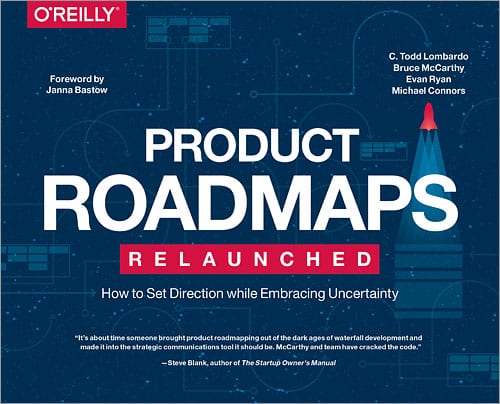At ProductPlan, we’re avid readers. We have a regular book club where we read and discuss books on a range of topics, including product management, software development, entrepreneurship, marketing, and more. We’ve put together a list of great books for product managers, and followed up with another list of even more books for product managers with recommendations from our readers! So, given our affinity for books and our obvious interest in product roadmaps, we were excited to get our hands on a copy of Product Roadmaps Relaunched: How to Set Direction While Embracing Uncertainty by C. Todd Lombardo, Bruce McCarthy, Evan Ryan, and Michael Connors.
Product Roadmaps Relaunched offers a great overview of the importance of product roadmaps, their relationship to product managers and product strategy, their significance as a communication tool, and the ways that they’ve changed and evolved over the years. This blog post offers a quick rundown of each of the book’s chapters, along with our favorite takeaways.
Chapter 1: Relaunching Roadmaps
The first chapter of Product Roadmaps Relaunched breaks down some misconceptions about product roadmaps and offers some great historical context and background. This preliminary chapter defines some key terms in product management and roadmapping, including “audience,” “stakeholders,” and more. We thought this chapter did a great job of emphasizing the strategic (and practical) importance of the roadmap: “Properly done, a product roadmap can steer your entire organization toward delivery on the company strategy.”
Chapter 2: Components of a Roadmap
This chapter walks readers through the basic building blocks of a roadmap while referring to several visual examples. Though it touches on the literal components of the roadmap, like bars, lanes, etc., this particular chapter highlights strategic components like goals, audience, and the roadmap’s status as a communication tool. We enjoyed the way the authors broke a product roadmap into three different layers of information: primary, secondary, and complementary. Roadmaps feature components like product vision (primary layer), confidence ratings and target customers (secondary layer), as well as project information and things like platform dependencies (complementary layer).
Chapter. 3: Gathering Inputs
This third chapter describes the different stages in a product’s life cycle, explains how to gather inputs from all the critical areas for a product manager, including the market and business environment, relevant internal and external stakeholders, and customers. Whereas the first two chapters focus more on the fundamentals of roadmaps and their role in crafting and communicating product strategy, this chapter focuses more on informing that process, highlighting the steps required of product managers before they ever start building a roadmap: “The goal of gathering inputs is to make sure you have all of the relevant information and context you need to make good product decisions.”
Tweet This:
“The goal of gathering inputs is to make sure you have all of the relevant information and context you need to make good product decisions.”
Chapter 4: Establishing the Why with Product Vision and Strategy
This chapter covers the difference between mission, vision, and values and explains how to create and communicate your product vision. It does a great job covering the basics of developing a functional product strategy for achieving that vision and emphasizes the importance of defining success metrics early on. We enjoyed that they go to such lengths to differentiate between these terms, which we often see used interchangeably. We especially love the way they put “real people” directly into their description of a product vision’s purpose: “A product vision should be about having an impact on the lives of the people your product serves, as well as your organization.”
Chapter 5: Uncovering Customer Needs Through Themes
Chapter five discusses the importance of understanding and expressing customer needs on your product roadmap. It highlights the process of defining themes and subthemes, explains how to use job stories and user stories to support those themes, and describes ways to relate those themes to objectives. This chapter also describes how to think about the relationship between product features and your roadmap. Phew! There’s a lot going on in this one, but it’s an extremely important grouping of topics under the umbrella of thinking about customer needs. Without a formalized approach to uncovering your customers’ needs, how would you possibly approach the development of an actionable product strategy and roadmap: “Most of the items on your roadmap should be focused on serving the customer.”
Chapter 6: Deepening Your Roadmap
At this point, the readers start shifting the conversation from the basics of constructing a roadmap to more advanced topics, like layering customer and market data onto your roadmap. This chapter describes how themes and features can work together, how information about personas and target customers relates to roadmap construction, and how to leverage this kind of information to better communicate your product strategy and increase stakeholder confidence in your vision. The authors argue that when weighing the benefits of this additional information against your roadmap’s overall clarity, legibility, etc., it’s important to “strive for balance.” Things like customer data or market information can be “added to the roadmap to strengthen the content and make it more useful for your stakeholder audiences,” but they can also complicate the visual look and overload the viewer. It’s good to land somewhere in the middle.
Chapter 7: Prioritizing—with Science!
This chapter also takes a step back to the moment before you start adding items to your roadmap and carefully examines prioritization. The chapter introduces some common prioritization frameworks, as well as some common but unrecommended prioritization methods, and also looks at the “limitations of using a scoring approach to product decisions.” Though it’s great that the authors do such a thorough job walking the reader through several common prioritization methods, the value for us was in their contextualization of prioritization as just one step in the process of figuring out what actually makes it onto your roadmap.
Sure, if you’ve managed to apply a prioritization framework, you may have narrowed your list of items down a bit from where you started, but there are still other factors to consider before you bulk add this list to a roadmap. The authors explain that these “resulting priorities should be directionally correct, but they will require an additional layer of practical considerations before they can be scheduled for work.” These other factors include “dependencies, resources, and promises” (to customers and other stakeholders).
Chapter 8: Achieving Alignment and Buy-in
The final few chapters of the book are devoted to activities that we at ProductPlan hold near and dear: achieving stakeholder alignment and presenting your visual roadmap. The eighth chapter provides an overview (and some great concrete advice) around topics related to alignment. The authors actually break down buzzwords like “alignment, consensus, and collaboration,” to provide some useful distinctions for product managers. Some of their suggestions for achieving alignment include being diplomatic and open to external feedback, performing a “roadmap co-creation workshop,” and how to leverage product-focused software to better align teams.
The resulting chapter offers a pretty grounded set of strategies for approaching what we often hear is one of the more difficult parts of a product manager’s job description. To quote the authors: “You can create the best plan ever conceived, but it will work only if the people who fund it, execute it, and receive its output believe in it.”
Tweet This:
“You can create the best plan ever conceived, but it will work only if the people who fund it, execute it, and receive its output believe in it.”
Chapter 9: Presenting and Sharing Your Roadmap
By this point in the book, you’ve got a solid grasp of prioritization methods, you’ve assembled your roadmap, and you’ve thought carefully about things like your customers and business goals. This chapter prepares you to make the most of your newly-constructed roadmap by focusing on the acts of presenting and sharing your roadmap. The authors argue why you should share your roadmap internally and externally, the risks associated with both contexts, and whether and how you should create and present different versions of your roadmap to different stakeholders.
Chapter 10: Keeping It Fresh
The penultimate chapter takes a high-level look at the roadmap as a strategic tool, and considers why and how the roadmap should evolve, how far out your roadmap should go, ways to manage planned and unplanned change, and how to communicate that change to stakeholders. At ProductPlan, we tend to think of roadmaps as living organisms. Your product strategy is going to grow and change over time and your roadmap should change and grow along with it. We love how the authors put it so succinctly: “When conditions in the environment change, your roadmap—like any living thing—must change as well in order to survive.”
Chapter 11: Relaunching Roadmaps in Your Organization
The final chapter takes on the title of the book itself, thinking about the place of the roadmap within the organization and product management as a discipline. This chapter helps readers assess the health of their organization’s roadmap and determine whether it’s time to “course-correct or have a full relaunch.” Whatever the status of your current roadmap (and wherever you might be on the product manager career path), this book does an excellent job of explicating some of the subtleties of roadmapping as a practice and an art. It does a great job positioning the roadmap as one of a product manager’s most powerful tools.
Read this book too? Please share your thoughts in the comments section below!




